| dc.contributor.author | Lucena, Felipe Amélio de | |
| dc.date.accessioned | 2021-06-23T11:51:04Z | |
| dc.date.available | 2021-06-23T11:51:04Z | |
| dc.date.issued | 2020-07-28 | |
| dc.identifier.citation | LUCENA, Felipe Amélio de. Produção de recobrimentos resistentes ao desgaste através de laser cladding de pós das ligas amorfizáveis fe-co-nb-b-(y). 2020. Tese (Doutorado em Ciência e Engenharia de Materiais) – Universidade Federal de São Carlos, São Carlos, 2020. Disponível em: https://repositorio.ufscar.br/handle/ufscar/14412. | * |
| dc.identifier.uri | https://repositorio.ufscar.br/handle/ufscar/14412 | |
| dc.description.abstract | Industrial components can be subjected to a high level of surface wear it
necessary to search for new wear-resistant alloys to improve the performance
and safety of the components. The objective of this work was to produce laser
coatings with high hardness and high wear resistance. Three new vitreous
alloys of the Fe-Co-Nb-B-Y system were produced in the arc furnace integrated
with the suction system using commercial raw materials (Fe-Nb and Fe-B
ferroalloys). Subsequently, through the high energy milling process of the splat
plates (> 10 cm) generated during gas atomization, powders (∅ <45 μm) were
formed for Fe66Co7Nb4B23 and Fe63Co7Nb4B23Y3 (% at.) alloys. Three different
coatings (B, C and D) were produced using the Fe66Co7Nb4B23Y3 (% at.) alloy
and one coating (A) for the Fe66Co7Nb4B23 (% at.) alloy for comparison. Each
coating was produced using different laser parameters and the powders from
the milling. The coatings were subjected to the wear test of pin on disk and
Vickers hardness. The “A” coating showed a lower average value of the specific
wear rate (2.20 x10-5 mm3/Nm) and a higher average value of the friction
coefficient (≈ 1.15) compared to “B” coating. The laser remelting process
applied over “C” coating and the addition of a second coating layer in the
formation of “D” coating did not significantly change its specific wear rates,
which were similar in “B” coating (10.9 x 10-5 mm3/Nm). The friction coefficient
of “B” coating (≈ 0.5) increased to ≈ 0.7 after its laser remelting for the formation
of “C” coating and decreased to ≈ 0.35 in “D” coating with the addition of a
second coating layer. The laser cladding process allowed the production of
coatings with high hardness (575 ± 60 to 1160 ± 80 HV). | eng |
| dc.description.sponsorship | Não recebi financiamento | por |
| dc.language.iso | por | por |
| dc.publisher | Universidade Federal de São Carlos | por |
| dc.rights | Attribution-NonCommercial-NoDerivs 3.0 Brazil | * |
| dc.rights.uri | http://creativecommons.org/licenses/by-nc-nd/3.0/br/ | * |
| dc.subject | Liga vítrea à base de Fe | por |
| dc.subject | Pós atomizados | por |
| dc.subject | Laser cladding | por |
| dc.subject | Microdureza | por |
| dc.subject | Desgaste | por |
| dc.subject | Fe-based bulk metallic glasses | eng |
| dc.subject | Coating | eng |
| dc.subject | Wear | eng |
| dc.subject | Pin on disk | eng |
| dc.subject | Microhardness | eng |
| dc.subject | Supercooled liquid | eng |
| dc.title | Produção de recobrimentos resistentes ao desgaste através de laser cladding de pós das ligas amorfizáveis fe-co-nb-b-(y) | por |
| dc.title.alternative | Production of wear resistance coating by laser cladding using glassy powders of fe-co-nb-b-(y) alloy system | eng |
| dc.type | Tese | por |
| dc.contributor.advisor1 | Afonso, Conrado Ramos Moreira | |
| dc.contributor.advisor1Lattes | http://lattes.cnpq.br/2176215981291453 | por |
| dc.description.resumo | Os componentes industriais podem ser submetidos a elevado nível de
desgaste superficial fazendo-se necessária a busca de novas ligas resistentes
ao desgaste a fim de melhorar o desempenho e segurança dos componentes.
O objetivo deste trabalho foi produzir revestimentos por laser com elevada
dureza e alta resistência ao desgaste. Foram produzidas no forno a arco
integrado ao sistema de sucção três novas ligas vítreas do sistema Fe-Co-Nb-
B-Y usando matérias-primas comerciais (ferroligas Fe-Nb e Fe-B).
Posteriormente, através do processo de moagem de alta energia das placas de
splats (>10 cm), geradas durante a atomização, foram formados pós (∅<45 μm)
de dois grupos Fe66Co7Nb4B23 e Fe63Co7Nb4B23Y3 (%at.). Foram produzidos,
através do processo de laser cladding, três diferentes revestimentos (B,C e D)
com a liga Fe66Co7Nb4B23Y3 (%at.) e um revestimento (A) com a liga
Fe66Co7Nb4B23 (%at.) para comparação. Cada revestimento foi produzido
utilizando diferentes parâmetros laser e os pós provenientes da moagem,
sendo submetidos ao ensaio de desgaste de pino sobre disco e de dureza
Vickers. O revestimento A apresentou menor valor médio da taxa específica de
desgaste (2,20 x10-5 mm3/N.m) e maior valor médio do coeficiente de atrito (≈
1,15) em comparação com o revestimento B. O processo de refusão a laser
aplicado sobre o revestimento C e a adição de uma segunda camada de
revestimento na formação do revestimento D não alteraram significativamente
suas taxas específicas de desgaste, que foram semelhantes no revestimento B
(10,9 x10-5 mm3/N.m). O coeficiente de atrito do revestimento B (≈ 0,5)
aumentou para ≈ 0,7 após sua refusão a laser para a formação do revestimento
C e diminuiu para ≈ 0,35 no revestimento D com a adição de uma 2a camada
de revestimento. O processo de laser cladding permitiu a produção
revestimentos com elevada dureza (575±60 até 1160±80 HV). | por |
| dc.publisher.initials | UFSCar | por |
| dc.publisher.program | Programa de Pós-Graduação em Ciência e Engenharia de Materiais - PPGCEM | por |
| dc.subject.cnpq | ENGENHARIAS::ENGENHARIA DE MATERIAIS E METALURGICA | por |
| dc.publisher.address | Câmpus São Carlos | por |
| dc.contributor.authorlattes | http://lattes.cnpq.br/0474221317198742 | por |


